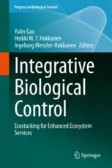Search
Search Results
-
Agroecosystem Design Supports the Activity of Pollinator Networks
The ecological compensation areas are hedges, woods, field margins, uncultivated land and the wild nectariferous/polliniferous plants that form the...
-
Vector transmission and epidemiology of ‘Candidatus Phytoplasma pyri’ in Austria and identification of Cacopsylla pyrisuga as new pathogen vector
Pear decline, induced by the phytoplasma ' Candidatus Phytoplasma pyri', transmitted by pear psyllids, is one of the most devastating diseases on Pyrus...

-
A whole ecosystem approach to pear psyllid (Cacopsylla pyri) management in a changing climate
Whole ecosystem-based approaches are becoming increasingly common in pest management within agricultural systems. These strategies consider all...

-
Soil microbiomes and one health
The concept of one health highlights that human health is not isolated but connected to the health of animals, plants and environments. In this...

-
Characterization of the Leaf Microbiome from Whole-Genome Sequencing Data of the 3000 Rice Genomes Project
BackgroundThe crop microbial communities are shaped by interactions between the host, microbes and the environment, however, their relative...

-
Semiochemicals and Their Potential Use in Pest Management in Horticultural Crops
Semiochemicals have been exploited in several ways to manage insect pests. These include monitoring and detection, population suppression through...
-
A scaffold-level genome assembly of a minute pirate bug, Orius laevigatus (Hemiptera: Anthocoridae), and a comparative analysis of insecticide resistance-related gene families with hemipteran crop pests
BackgroundOrius laevigatus , a minute pirate bug, is a highly effective beneficial predator of crop pests including aphids, spider mites and thrips...

-
Drought legacy in rhizosphere bacterial communities alters subsequent plant performance
PurposeRhizosphere bacterial communities (‘rhizobacteria’) can mediate plant-soil feedbacks that enhance plant drought tolerance, but the composition...

-
Soil chemistry and fungal communities are associated with dieback in an Endangered Australian shrub
Background and aimsField surveys across known populations of the Endangered Persoonia hirsuta (Proteaceae) in 2019 suggested the soil environment...

-
Chemical and Natural Pesticides in IPM: Side-Effects and Application
The regulation for the registration and use of pesticides, also including natural products, currently in place in the different countries, although...
-
Enhancement of Natural Control Function for Aphids by Intercrop** and Infochemical Releasers in Wheat Ecosystem
Wheat Triticum aestivum is the most important food crop in the world. In China, wheat is the second largest crop after rice in cultivated area, and...
-
Induction of plant defenses: the added value of zoophytophagous predators
Several biological control agents of the hemipteran insect families Miridae, Anthocoridae and Pentatomidae, as well as mites of the family...

-
Efficacy evaluation of alternative pest control products against Drosophila suzukii in Austrian elderberry orchards
Drosophila suzukii Matsumura (Diptera: Drosophilidae) is a significant pest in soft fruits such as elderberries. Laying of eggs into fruits shortly...

-
Pest Management in Horticultural Crops Under Protected Cultivation
Greenhouse horticultural crops grown all over the world are vulnerable to various pest attacks as the protected crops provide stable and favourable...
-
Dispersion patterns and monitoring samplings of termite pests in cocoa agroforestry systems of Southern Cameroon
Termites are major emerging pests of cocoa in Africa. However, their dispersion models on cocoa trees as well as their sampling plans remain unclear....

-
Maternal amoxicillin affects piglets colon microbiota: microbial ecology and metabolomics in a gut model
AbstractThe first weeks of life represent a crucial stage for microbial colonization of the piglets’ gastrointestinal tract. Newborns’ microbiota is...

-
Development of abamectin resistance in Tetranychus urticae in Australian cotton and the establishment of discriminating doses for T. lambi
Since the 1980s Tetranychus urticae Koch has dominated Australian cotton due to its ability to develop resistance. Here we give screening data for a...
-
Recent advances in engineering crop plants for resistance to insect pests
BackgroundWhile the rapidly increasing global population has led to a dramatically increased demand for the agricultural production, there have been...

-
Integrated pest management: good intentions, hard realities. A review
Integrated Pest Management (IPM) provides an illustration of how crop protection has (or has not) evolved over the past six decades. Throughout this...

-
Hymenopteran Parasitoids in Cultivated Ecosystems: Enhancing Efficiency
Biological control is an eco-friendly approach to encounter pests in cultivated ecosystems. The major pest outbreaks with the key economically...
